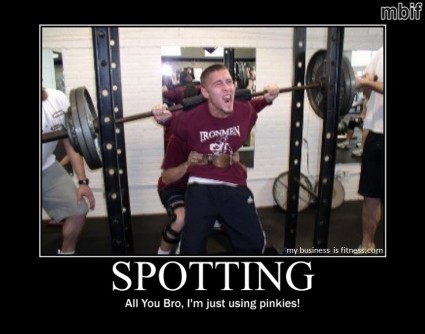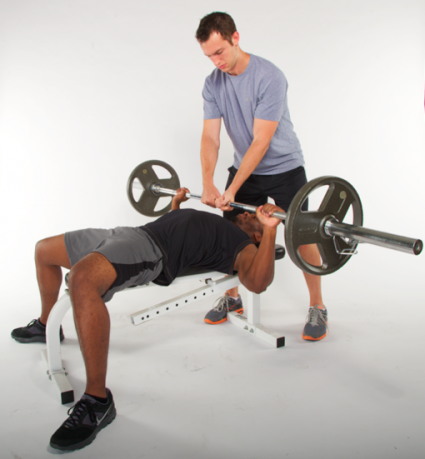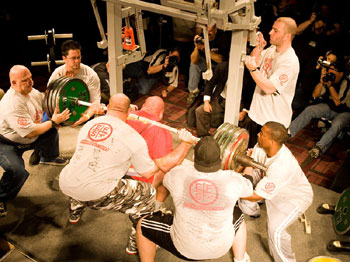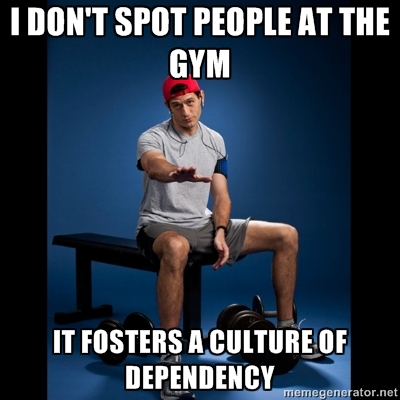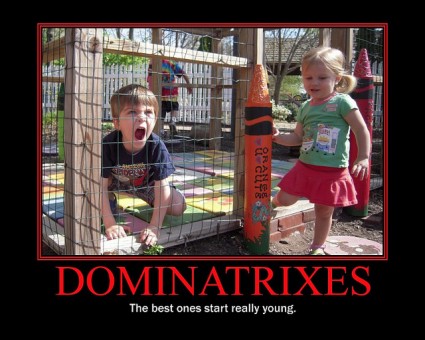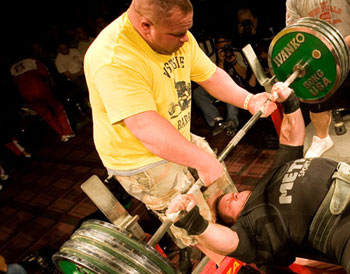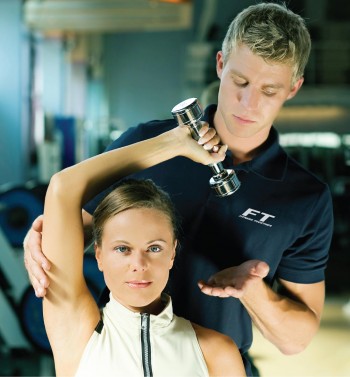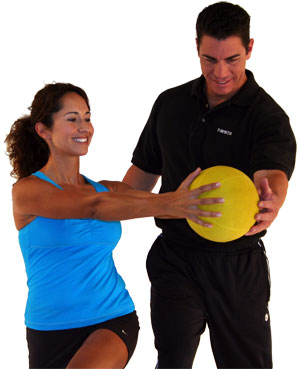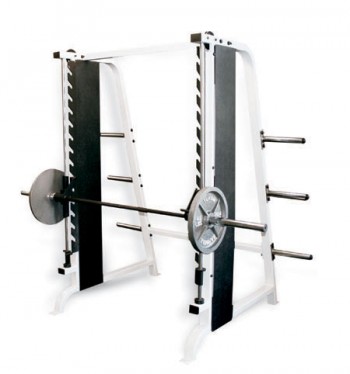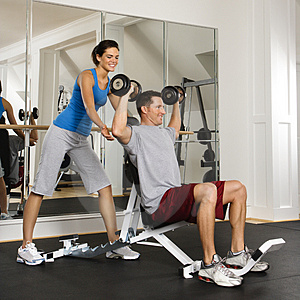“Can I get a spot Bro?”
That question gets asked in gyms all day everyday.
And what results is either:
- A 2 man lift.
- Someones life being at stake.
- Or you’re better off having not even asked in the first place.
Spotting is about one thing only, not helping the lifter lift the weight, not getting involved, NOT yelling “All You”.
It’s about: MAKING SURE THE LIFTER DOESN’T DIE GET HURT…..
That’s it.
As a spotter your job is to just make sure catastrophe doesn’t happen because a lift goes to hell. Which brings us to our first rule.
RULE #1: Only Get a Spot for Rep Max (RM) lifts.
This doesn’t mean you only need a spot when your trying to hit a new 1 RM (rep max).
It means that ANY max lift, be it a 3RM, 5RM 10RM, 100RM, it’s a good idea to get a spot because RM does mean “rep max” as in I CAN’T DO ANY MORE…
ie a 10RM is only a 10RM if you can’t get 11. If you can get 11 it might be an 11RM but it’s not a 10RM.
As I was saying, if you’re going for a rep max in a set, you should get a spot because that last rep or two or three (on higher rep sets) could:
- Get a little hairy.
- Give you the confidence to
not crap your pantsstay focused on your technique and the lift instead of focusing on not killing yourself.
Plus, if that spotter actually has a clue and they’re a good coach, and not a cheerleading Bro, they’ll help you keep that technique, focus, and get the most out of yourself on each lift of that set which should give you your best possible performance.
HAHAHA, wonky political/ gym joke…But there is a lot of truth in that statement.
Don’t ask for a spot with a weight you know you can handle.
If you do you WILL become dependent on the spotter to keep you on track and safe and you will start “missing” lifts that you could have made had you stayed focused and aggressive.
The truth is YOU are responsible for knowing your limits, understanding your body, keeping yourself safe and most importantly lifting the weight.
So it’s a good rule to keep it to BIG Rep Max lifts…
RULE #2: Spotting is NOT helping lift the weight.
General rule of spotting:
If the spotter touches the bar or lifter the lift is no good.
Simple as that.
If someone touches the bar, the lift wasn’t completed.
When spotting someone, or if someone is spotting you make sure you both understand this rule.
“Don’t touch the bar but to save the lifter from disaster.”
I can’t tell you how many times I’ve been going for a record assuming that my spotter understood this only to have a great set completely negated and thrown on the trash heap of history simply because my spotter became overzealous or overreacted and touched or grabbed the bar prematurely.
Tool touches bar the whole time….guess what? THIS LIFT NEVER HAPPENED!
Don’t waste effort….
Let the lifter lift the weight. A good spotter is like a baseball umpire. At their best when they’re not a noticeable part of the game.
Granted, with someone who is VERY experienced this rule can be somewhat disregarded.
If I’m spotting someone and touch the bar or them, I know if I’m giving them the confidence to complete the exercise, a technique reminder, or taking weight off the bar.
If it’s the first two, I still count it as a good lift, the last one the lift is a no go, no matter how little help was given.
RULE #3: Have a “Safe Word”….yes a “safe word” but not that way, you perverts…
The universal “Safe Word” in the lifting community is:
“Take it”
“Take it” means, “I’m about to die, grab the bar NOW”.
This is really what the spotter is for, it’s not the spotters job to decide when the lift is over, it’s ultimately the lifters responsibility.
This video is completely mislabeled, it should be “How to Spot”…Once he fails the lift you can hear “take it” it’s a reflex reaction at this point.
Obviously, he has failed the lift but the spotters didn’t interfere with the attempt they were alert and responded but notice the lifter reflexively gives the “take it” command……This was good spotting…
RULE #4: The Spotter HELPS to Rack the Weight, NOT Rack it For You
The Spotters job is only to help the lifter rack the weight NOT to somehow magically remove the weight from the lifter and float it into the j-hooks if the lifter gets into trouble.
This should NEVER happen but does:
- Lifter begins to struggle
- Bar stalls
- Lifter says “take it”
- Spotter grabs the bar
- Lifter completely STOPS pushing/ straining and completely relaxes
- Spotter dies…
Well not really, but in this scenario the spotter and the lifter are in REAL and PRESENT, immediate, danger.
Just because the spotter is there and you’ve given them the “take it” command doesn’t mean you’re out of the woods.
You’re NEVER out of danger until the bar is RACKED. Don’t relax at all until the bar is back in the j-hooks.
RULE #5: If the Bar Moves Down…GRAB IT!!
The “take it” command isn’t the only time you need to grab a bar as a spotter.
The Spotter needs to end the lift if the bar moves down at ALL.
A bar that stalls for a second or two with an experienced lifter is fine.
A slow grinding lift that takes forever, as long as technique is ok, is fine.
A movement in which the bar moves in the wrong direction (usually down) is NOT, and that lift MUST be aborted.
If the bar moves down at all rack the weight.
Yes, I know bodybuilders use Forced Reps all the time and this rule doesn’t apply, but you probably don’t and don’t know what they are any way and if you did you wouldn’t be reading an article about how to spot someone and not look like a fool so it doesn’t matter any way.
But here’s a video that explains Forced Reps with Jim Stoppani. He’s jacked, smart and has some sick tattoos and it’s a good video.
RULE #6: Not All Lifts Can be Spotted
Olympic lifts…you don’t spot.
Deadlifts…you don’t spot.
Explosive/ Fast movements….you don’t spot.
There is either no need, or to try to spot these exercises would be dangerous.
Think about it: Where and how could you spot her without endangering yourself or her in the process?
A: You can’t..
RULE #7: Not All Lifts Should be Spotted
Bicep curls, lateral raises, calf raises, front raises, pullups…
You can but don’t need a spot for most lifts despite what most stock personal trainer/ fitness photos would suggest.
Ummm, he’s spotting the ball…
There is a big difference between not being able to grind out that last bicep curl and failing with 315lbs on your back. Don’t get/ give spots when you don’t need them.
If you feel the need to get spots for little lifts like biceps curls, lateral raises, calf raises etc, grow some sacks..
Keep the spots for things that could actually jack you up if things went wrong.
Things like:
- Squats
- Front Squats
- Bench Press
- Dumbbell Bench Press
- Seated Overhead Press
- Dumbbell Flys (maybe, if you’re really strong the arm and shoulder are in a pretty precarious situation at the bottom. But you probably don’t need a spot if you’re strong cause you would already understand that this lift didn’t get you strong and you’ll understand that it’s probably not worth pushing so hard that you can get hurt when the results from it are so small).
RULE #8: Smith Machines (Expensive Coat Racks)
Don’t be a gym tool.
Asking for a spot on anything that’s done on a Smith Machine makes you a tool.
The Smith Machine is BUILT to be a spotter, that’s the entire purpose for its existence.
Unless the bar is really loaded up and you’re doing a very long, hard set, to the point where even turning the bar to rack the weight may be dangerous, don’t ask for a spot when using the Smith.
You can qualify for a spot on the Smith at three 45lbs plates per side and 10 reps per set.
At that point you can ask for a spot, but you’ll be pretty strong, probably not using a Smith for your lifting and if you are you’ll understand that to ask for a spot on the Smith is to be a gym tool and pretty stupid so you won’t do it anyway.
RULE #9: Don’t Be a Cheerleader, Be A Coach
Yelling, “ALL YOU” or “YOU GOT IT” is a waste of time.
I’m lifting the weight…it should be “ALL ME” and “NONE YOU”.…
Remember, if the spotter touches the weight, the lift doesn’t count, so of course it’s “ALL ME”. If it’s not either you’re not doing your job or I’m not lifting the weight and it’s not “all me”.
As a lifter, help me, give me a cue to focus on to help keep my technique in line.
On a squat a good series of cues a spotter could give would be:
While setting up at the rack:
- “Shoulders Tight”
- “Get into the bar”
- “Squeeze the bar”
- “Get tight”
While unracking and setting up:
- “Stand Tall”
- “Settle”
- “Get Tight”
While lowering in the squat:
- “Hips Back”
- “Knees Out”
- “Chest up”
While coming up out of the bottom:
- “Head Up”
- “Elbows Down”
- “Knees Out”
- “Chest Up”
I’m not saying give ALL of these cues. Doing that would result in information overload for the lifter and a horrible lift.
Just use one or two cues that would help the lifter stay focused on weak technique points keeping their technique tight and on point increasing the chances of successfully and safely completed lift.
Rule #10: Know HOW to Spot…
This is BAD, not to mention stupid, spotting technique…
Technique counts, even when spotting, knowing where to be and where to grab if necessary matters.
Some of the common spotting techniques are incredibly dangerous for the lifter and the spotter…
So spotting technique is the subject of the Next Post…..

